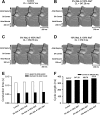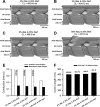Altered sinoatrial node function and intra-atrial conduction in murine gain-of-function Scn5a+/ΔKPQ hearts suggest an overlap syndrome
- PMID: 22287583
- PMCID: PMC3330789
- DOI: 10.1152/ajpheart.00357.2011
Altered sinoatrial node function and intra-atrial conduction in murine gain-of-function Scn5a+/ΔKPQ hearts suggest an overlap syndrome
Abstract
Mutations in SCN5A, the gene encoding the pore-forming subunit of cardiac Na(+) channels, cause a spectrum of arrhythmic syndromes. Of these, sinoatrial node (SAN) dysfunction occurs in patients with both loss- and gain-of-function SCN5A mutations. We explored for corresponding alterations in SAN function and intracardiac conduction and clarified possible mechanisms underlying these in an established mouse long QT syndrome type 3 model carrying a mutation equivalent to human SCN5A-ΔKPQ. Electrophysiological characterizations of SAN function in living animals and in vitro sinoatrial preparations were compared with cellular SAN and two-dimensional tissue models exploring the consequences of Scn5a+/ΔKPQ mutations. Scn5a+/ΔKPQ mice showed prolonged electrocardiographic QT and corrected QT intervals confirming long QT phenotypes. They showed frequent episodes of sinus bradycardia, sinus pause/arrest, and significantly longer sinus node recovery times, suggesting compromised pacemaker activity compared with wild-type mice. Electrocardiographic waveforms suggested depressed intra-atrial, atrioventricular node, and intraventricular conduction in Scn5a+/ΔKPQ mice. Isolated Scn5a+/ΔKPQ sinoatrial preparations similarly showed lower mean intrinsic heart rates and overall slower conduction through the SAN to the surrounding atrium than did wild-type preparations. Computer simulations of both single SAN cells as well as two-dimensional SAN-atrial models could reproduce the experimental observations of impaired pacemaker and sinoatrial conduction in terms of changes produced by both augmented tail and reduced total Na(+) currents, respectively. In conclusion, the gain-of-function long QT syndrome type 3 murine Scn5a+/ΔKPQ cardiac system, in overlap with corresponding features reported in loss-of-function Na(+) channel mutations, shows compromised SAN pacemaker and conduction function explicable in modeling studies through a combination of augmented tail and reduced peak Na(+) currents.
Figures









Similar articles
-
Atrial arrhythmogenicity in aged Scn5a+/DeltaKPQ mice modeling long QT type 3 syndrome and its relationship to Na+ channel expression and cardiac conduction.Pflugers Arch. 2010 Aug;460(3):593-601. doi: 10.1007/s00424-010-0851-z. Epub 2010 Jun 16. Pflugers Arch. 2010. PMID: 20552221 Free PMC article.
-
Sinus node dysfunction following targeted disruption of the murine cardiac sodium channel gene Scn5a.J Physiol. 2005 Sep 1;567(Pt 2):387-400. doi: 10.1113/jphysiol.2005.083188. Epub 2005 Jun 2. J Physiol. 2005. PMID: 15932895 Free PMC article.
-
Mechanistic links between Na+ channel (SCN5A) mutations and impaired cardiac pacemaking in sick sinus syndrome.Circ Res. 2010 Jul 9;107(1):126-37. doi: 10.1161/CIRCRESAHA.110.219949. Epub 2010 May 6. Circ Res. 2010. PMID: 20448214 Free PMC article.
-
SCN5A and sinoatrial node pacemaker function.Cardiovasc Res. 2007 Jun 1;74(3):356-65. doi: 10.1016/j.cardiores.2007.01.009. Epub 2007 Jan 19. Cardiovasc Res. 2007. PMID: 17368591 Review.
-
Genetic Na+ channelopathies and sinus node dysfunction.Prog Biophys Mol Biol. 2008 Oct-Nov;98(2-3):171-8. doi: 10.1016/j.pbiomolbio.2008.10.003. Epub 2008 Nov 5. Prog Biophys Mol Biol. 2008. PMID: 19027778 Review.
Cited by
-
Mouse Models of SCN5A-Related Cardiac Arrhythmias.Front Physiol. 2012 Jun 22;3:210. doi: 10.3389/fphys.2012.00210. eCollection 2012. Front Physiol. 2012. PMID: 22737129 Free PMC article.
-
The Genetic Puzzle of Familial Atrial Fibrillation.Front Cardiovasc Med. 2020 Feb 14;7:14. doi: 10.3389/fcvm.2020.00014. eCollection 2020. Front Cardiovasc Med. 2020. PMID: 32118049 Free PMC article. Review.
-
High-resolution Optical Mapping of the Mouse Sino-atrial Node.J Vis Exp. 2016 Dec 2;(118):54773. doi: 10.3791/54773. J Vis Exp. 2016. PMID: 28060289 Free PMC article.
-
Multiple targets for flecainide action: implications for cardiac arrhythmogenesis.Br J Pharmacol. 2018 Apr;175(8):1260-1278. doi: 10.1111/bph.13807. Epub 2017 May 12. Br J Pharmacol. 2018. PMID: 28369767 Free PMC article. Review.
-
Transverse cardiac slicing and optical imaging for analysis of transmural gradients in membrane potential and Ca2+ transients in murine heart.J Physiol. 2018 Sep;596(17):3951-3965. doi: 10.1113/JP276239. Epub 2018 Jul 26. J Physiol. 2018. PMID: 29928770 Free PMC article.
References
-
- Ackerman MJ, Khositseth A, Tester DJ, Hejlik JB, Shen WK, Porter CB. Epinephrine-induced QT interval prolongation: a gene-specific paradoxical response in congenital long QT syndrome. Mayo Clin Proc 77: 413–421, 2002 - PubMed
-
- Baroudi G, Chahine M. Biophysical phenotypes of SCN5A mutations causing long QT and Brugada syndromes. FEBS Lett 487: 224–228, 2000 - PubMed
-
- Beaufort-Krol GC, van den Berg MP, Wilde AA, van Tintelen JP, Viersma JW, Bezzina CR, Bink-Boelkens MT. Developmental aspects of long QT syndrome type 3 and Brugada syndrome on the basis of a single SCN5A mutation in childhood. J Am Coll Cardiol 46: 331–337, 2005 - PubMed
-
- Benhorin J, Taub R, Goldmit M, Kerem B, Kass RS, Windman I, Medina A. Effects of flecainide in patients with new SCN5A mutation: mutation-specific therapy for long-QT syndrome? Circulation 101: 1698–1706, 2000 - PubMed
Publication types
MeSH terms
Substances
Grants and funding
LinkOut - more resources
Full Text Sources
Other Literature Sources
Molecular Biology Databases
Miscellaneous

